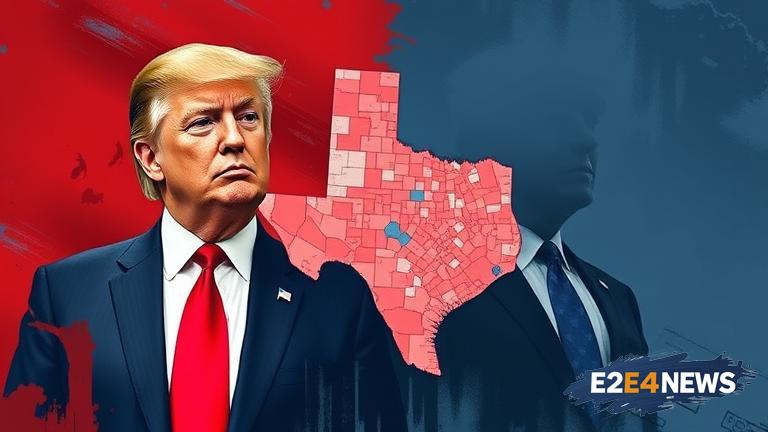The state of Texas is currently embroiled in a heated redistricting battle, with former President Donald Trump at the forefront of the controversy. The redistricting process, which occurs every decade, aims to redraw congressional and state legislative district boundaries to reflect changes in the state’s population. However, the process has been marred by allegations of gerrymandering and partisan manipulation. Trump, who has been a vocal supporter of the Republican Party’s efforts to redraw district boundaries, has been accused of attempting to influence the process for his own political gain. The former President’s involvement in the redistricting process has sparked concerns among Democrats and voting rights advocates, who argue that his actions could lead to the disenfranchisement of minority voters. The Texas redistricting battle is being closely watched by election experts and analysts, who see it as a key test of the Republican Party’s ability to maintain its grip on power in the state. The controversy has also highlighted the deepening partisan divide in Texas, with Democrats and Republicans locked in a bitter struggle for control of the state’s congressional delegation. Despite the controversy, Trump remains a popular figure in Texas, and his endorsement is still seen as a major boost for Republican candidates. However, his involvement in the redistricting process has also sparked concerns among some Republicans, who fear that his actions could backfire and harm the party’s chances in the 2024 election. The redistricting battle in Texas is also being driven by demographic changes in the state, with the Hispanic population growing rapidly in recent years. This shift has led to an increase in Democratic voting power, and Republicans are seeking to counter this trend by redrawing district boundaries to favor their own candidates. The use of gerrymandering tactics has been a major point of contention in the redistricting process, with Democrats arguing that Republicans are seeking to manipulate district boundaries to maintain their grip on power. The Supreme Court has ruled that gerrymandering is unconstitutional, but the practice remains widespread in many states, including Texas. The Texas redistricting battle is also being influenced by the ongoing debate over voting rights, with Democrats pushing for measures to expand access to the ballot and Republicans advocating for stricter voter ID laws. The controversy has sparked a national debate over the role of politics in the redistricting process, with many arguing that the process should be taken out of the hands of politicians and given to independent commissions. Despite the challenges, Trump remains committed to his efforts to influence the redistricting process in Texas, and his supporters see his involvement as a key factor in the state’s upcoming elections. The outcome of the redistricting battle in Texas is likely to have significant implications for the 2024 election, with the state’s 38 congressional seats up for grabs. The controversy has also highlighted the importance of voting rights and the need for fair and impartial district boundaries. As the redistricting process continues to unfold, it remains to be seen whether Trump’s efforts will ultimately succeed, or whether Democrats and voting rights advocates will be able to block his attempts to manipulate the system. The Texas redistricting battle is a complex and multifaceted issue, with many different factors at play. The use of data and technology is playing a major role in the redistricting process, with both parties using sophisticated mapping tools to draw district boundaries. The controversy has also sparked a debate over the role of the courts in the redistricting process, with many arguing that judges should play a more active role in overseeing the process. Ultimately, the outcome of the Texas redistricting battle will depend on a variety of factors, including the actions of Trump and other politicians, the decisions of the courts, and the efforts of voting rights advocates. As the process continues to unfold, it is clear that the Texas redistricting battle will be a major factor in shaping the state’s political landscape for years to come.





